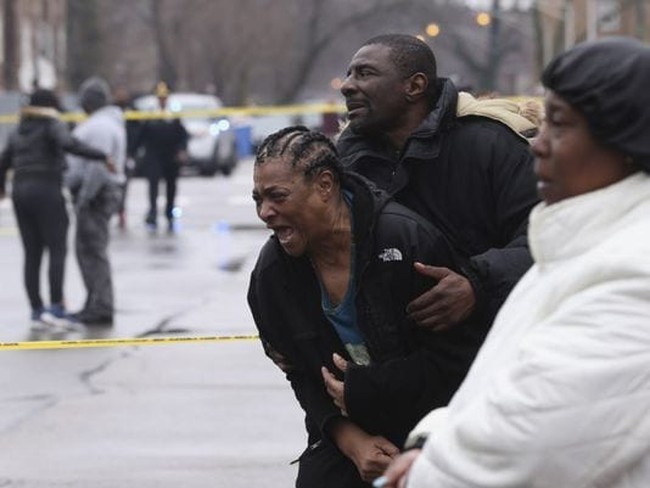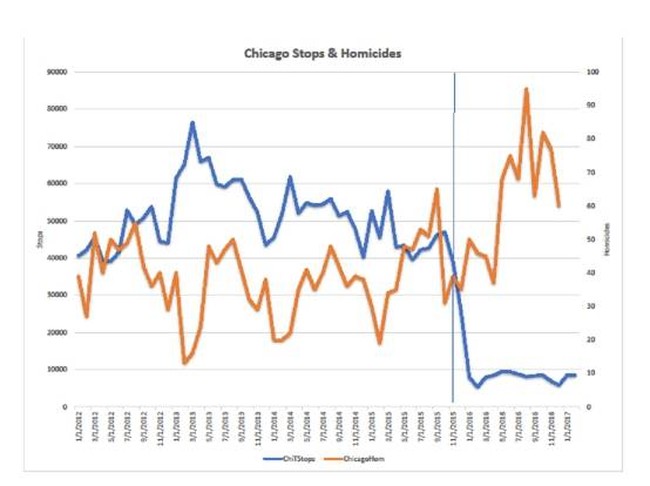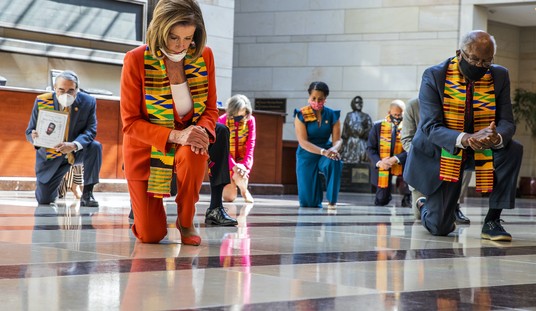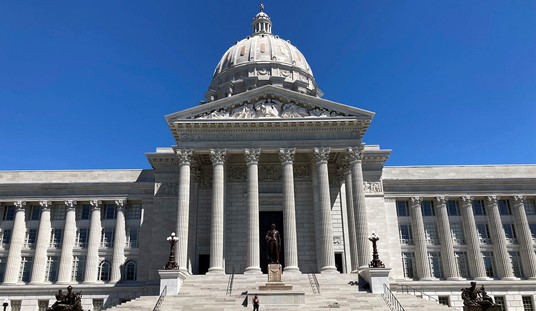
Georgia Jackson, 72, is overcome with emotion upon learning that her two grandsons, Raheem, 19, and Dillon Jackson, 20, were found fatally shot in the South Shore neighborhood in Chicago on Thursday, March 30, 2017. Seven people were slain in gun violence in the neighborhood over a 12-hour period Thursday, according to police.
(Photo: Chris Sweda, AP)
A good friend of mine used to be fond of saying that he’d prefer to go to prison as an innocent man than be freed by the efforts of the ACLU. Right now Chicago is in the midst of an ACLU field experiment that is proving the ACLU is pretty damned dangerous and you might be safer in prison than on a lot of Chicago’s streets after the ACLU got involved.
Up until 2015, Chicago PD had a fairly aggressive “stop and frisk” program that gave cops a substantial amount of leeway in stopping individuals with de minimus probable cause. In 2015, Chicago entered into a consent decree with the ACLU in which police had to extensively document their use of “stop and frisk.” Ostensibly, the goal was to prevent gangbangers…uh, minority youth, my bad…from being singled out. What followed was an 82-percent drop in stops and an increase of 240 homicides.
Two law professors at the University of Utah have analyzed this effect and determined that it goes well beyond correlation all the way to causation.
In our paper, Professor Fowles and I bring empirical research tools to bear in an attempt to identify what changed in Chicago during that time. While such analysis may be unable to provide absolutely definitive answers, it can suggest which factors are more likely than others to have been responsible. Given that, quite literally, more than two hundred additional victims died in 2016 in some of Chicago’s most impoverished neighborhoods—and more might similarly be killed in the future in Chicago and elsewhere—finding answers must be regarded as a high priority.
Our article proceeds in several steps. It begins by describing in general terms what is quite accurately called a “spike” in homicides in Chicago in 2016. A 58% year-to-year change in America’s “Second City” is staggering, suggesting something changed dramatically to initiate the increase.
We next attempt to pinpoint the time when things changed in Chicago—what might be called the “inflection” or “break” point in the data series. We begin by seasonally adjusting Chicago homicide and shooting data, which show significant seasonal fluctuation from cold weather months to warm weather months. Once the data are seasonally adjusted, a change or “break” in the data series can be statistically detected around November 2015.
We next explore the possibility that, as been suggested by a number of observers, a reduction in stop and frisks by the Chicago Police Department that began at the very end of 2015 was responsible for the homicide spike starting immediately thereafter. Good reasons exist for believing that the decline in stop and frisks caused the spike. Simple visual observation of the data suggests a cause-and-effect change. In the chart below, we depict the (seasonally unadjusted) monthly number of stop and frisks (in blue) and the monthly number of homicides (in gold). The vertical line is placed at November 2015—the break point in the homicide data. This is precisely when stop and frisks declined in Chicago.

Predictably, the ACLU is not happy at having the carnage laid at its door. But its defense is long of fully-woke rhetoric and short on facts:
The article is a repackaged version of the hateful rhetoric that Black and Latino people should be subjected to unconstitutional and abusive policing and the absurd suggestion that police officers will be too scared to do their jobs if they have oversight.
…
Before the CPD-ACLU agreement went into effect, the CPD stopped pedestrians at record-high levels and fully half of these stops were unconstitutional. Nothing in the agreement prevents the CPD from making lawful stops, and officers have continued to stop pedestrians.
Police, contrary to what the ACLU seems to think, are not stupid. Once you start having to document in excruciating detail your rationale for a stop, every stop you make becomes a potential career-ending fiasco. What percentage do you, as a patrol officer, gain by making a stop and possibly ending up suspended or terminated when you can not make the stop. This is what is known in risk-analysis as a “no-brainer.” When you combine this with a lot of the other things going on in 2015 in regards to #BlackLivesMatter and the anti-police Justice Department of Loretta Lynch, you got a conscious decision by a lot of police forces to “de-police” high-risk areas, figuring it was safer to come in and clean up the bodies than it was to be proactive an end up unemployed.
This is not to say that the ACLU was totally off base. The fact is that a black kid–all things being equal–should be at no greater risk of being stopped and searched by cops than a white kid. I get that. What I also get is that all things are not equal. And when you affirmatively intervene, under the color of protecting constitutional rights, you don’t have the ability to take no responsibility for several hundred additional homicides. The ACLU response is nothing less than what one would expect of a hardened sociopath. And that really isn’t an accident.














Join the conversation as a VIP Member